Kids are capable of learning their ABCs well before kindergarten—and they need to, in order to keep up with learning once they start formal schooling. However, it takes years to learn the 52 uppercase and lowercase letters, and to distinguish between similar ones like b and d. That’s why parents or early caretakers are the ideal candidates to teach kids the alphabet.
Teaching your child the ABCs isn’t onerous or difficult, with a little forethought. In fact, it can be lots of fun. Just introduce letters little by little over the years and incorporate these research-backed tips: Draw your child’s attention to print in books and your environment (telling them the sounds the letters make as well as their names), point out how the letters are formed, and help your little one start to make letters themselves.
This last point is a crucial part of the process because kids typically begin paying more attention to the features that distinguish letters when they start trying to write them. But you don’t have to wait for your little one to have the fine motor skills to create letters with a pencil. You can introduce them to the differences among letters, and let them practice forming them, by giving them letter-part cutouts to put together into letters. We call the activity DIY Letters.
And we’ve made it easy for you by creating printable letter parts. Just print them, cut them out, and laminate them. Then read on for how to use this simple, playful tool to teach your child the alphabet. We’ll explain the research behind teaching letter parts and give you the vocabulary to effectively teach your child.
Note: For tips on laminating your letter parts, scroll down. And for some awesome ABC books to read with your child as part of this DIY letters activity, scroll all the way down to the Book Pairing section at the end of this post.
Teach Your Child the ABCs with DIY Letters
Once you’ve laminated your letter parts, go ahead and build those letters! With your child, combine the straight and curved laminated pieces to create letters. First, demonstrate how to form various letters, then invite your child to do it on their own.
By placing two straight pieces together, you’ll have a T; with the two large curves you’ll create an O; a straight line with a curve can make a P, D, or B. In fact, your child will be able to make all 26 uppercase letters with the letter pieces you’ve printed out.
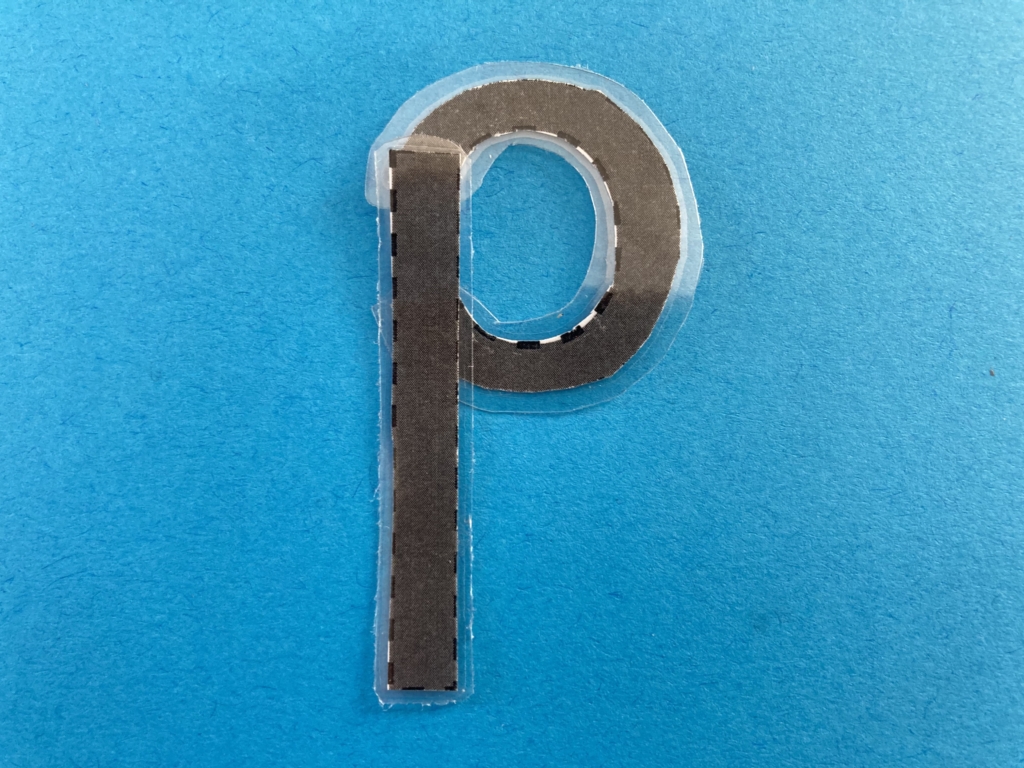

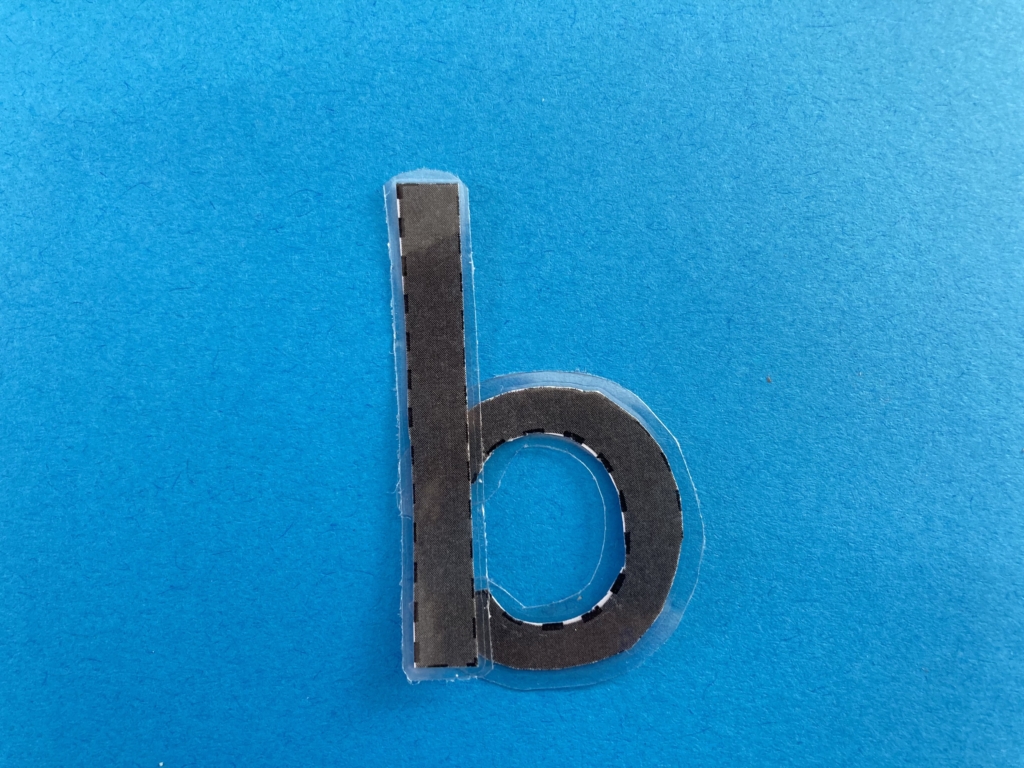
Research indicates that the details of letter formation help people tell letters apart. Elements like curves and lines, and specifics like where those terminate and intersect, are key to identifying and distinguishing letters.
So, as you and your child make letters, talk about their features and point out the elements that distinguish one letter from another—where the lines intersect in a T versus an X, or which way the curve opens in a C vs a U, for example.
Key features to point out within letters include short and long lines; open and closed curves; hooks, humps, and dots. If you consistently use these terms to refer to the relevant parts, your child will more quickly understand that these parts make up all the different letters, albeit combined in various different ways: horizontal, vertical, diagonal, overlapping, and more.
Learn more about how to talk about letters with your child in our post on teaching the alphabet.
Build on the Activity: Once your child has mastered individual letters, see if they can use the letter shapes to build simple words or their name. Print out as many copies of the letter parts as you need to spell all the words you like.
Tutorial — Laminating Your DIY Letters
Materials:
- Clear contact paper/self-laminating sheets
- Scissors
- Printer
- Paper
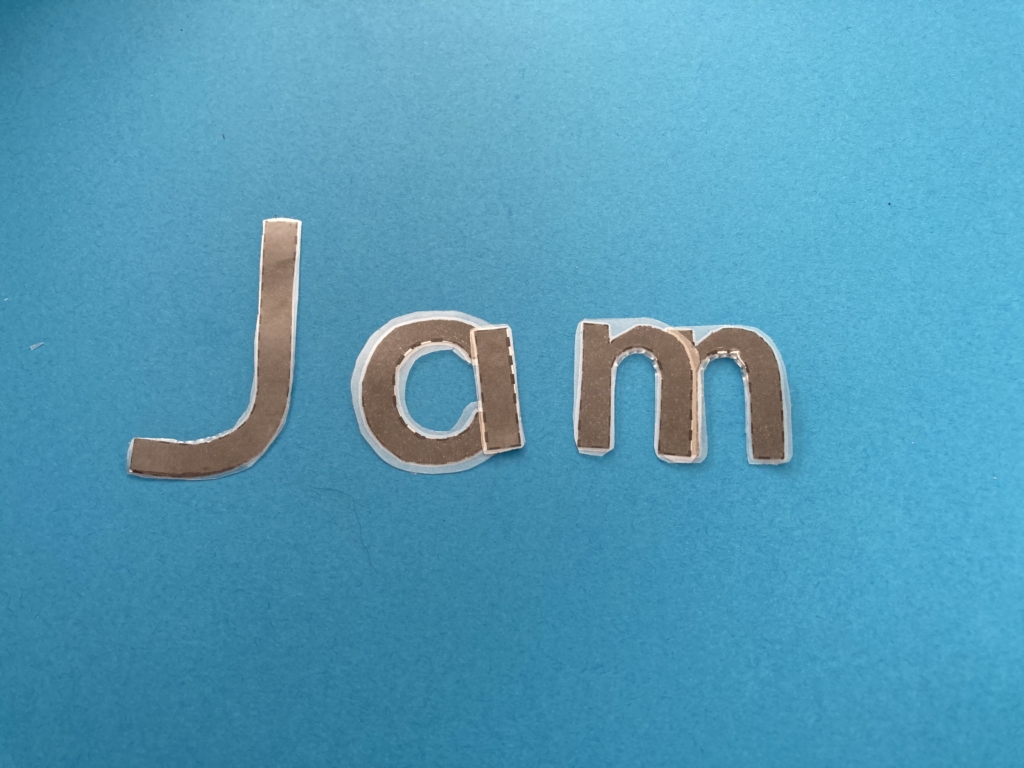
Step 1: Print two copies of the free DIY Letters printable from the VIP Vault, then cut out the letter parts. (If you don’t have a printer, you can also just draw the letter parts freeland. Use a ruler and curved surface to trace neater shapes.)
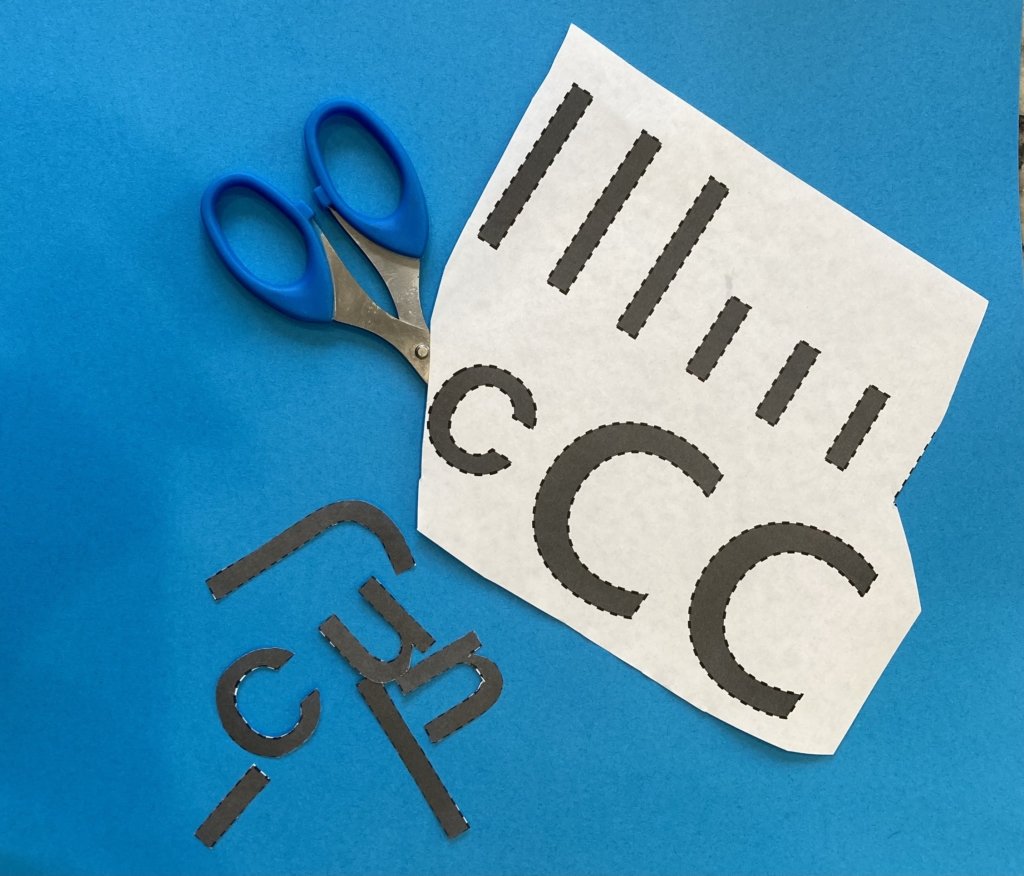
Step 2: Place the paper pieces between contact paper or in a laminating pocket, keeping them at least an inch apart to allow room to cut them out. Laminate or seal the contact paper, then cut out the laminated shapes, leaving a slight border around each. Tip: Round the corners so they’re not sharp.
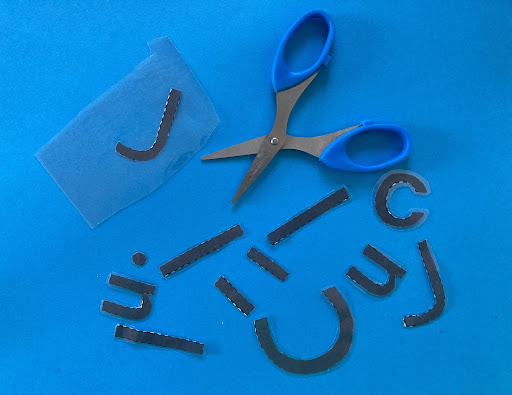
That’s it! Just repeat these steps as necessary to make as many letter parts as you like.
Like this post? Share it!
Book Pairing
We believe in adding in a story time to just about any activity you do with kids, from crafts and projects to outings and travel. Reading to your child is an excellent way to introduce kids to new topics and ideas, and reading about things you do together also helps keep them engaged and making the connection between print and real life.
And sharing a book (and pointing out the letters in it) is particularly well-suited for introducing this letter-part activity, as well as for reinforcing its lessons afterwards. You can draw attention to the alphabet when you share any book, but an ABC book is a natural choice to really put the spotlight on letters.
We love Itchy’s Alphabet for creatively highlighting letter shapes, or browse our list of awesome alphabet books and good books for getting preschoolers ready to read for more ideas. You can use any book that you have on hand or that’s available at your local library, though: When you draw on the skills we’ve discussed for how to talk about letters and their parts, you’ll be able to turn any book into a powerful vehicle for teaching letters.
Chugga chugga, choo choo! The digraph train is pulling into the station. What is a digraph, you ask? It’s when two letters combine to make a brand new sound, like C and H making the sound /ch/ (as in change).
Children learning to read encounter digraphs all over the place. Think of the words just in this sentence—think, the, and this all include the digraph TH. Other common ones include PH for /f/ and, of course, CH. Digraphs can be daunting for kids because they’ve already learned the most common sounds for each letter, and now the letters are making something brand new. But a bit of practice goes a long way. Make (and read) this cheese and chicken pasta recipe together, and your child will be on the road to reading CH like a champ! (Plus it’s a favorite with picky eaters!)
To begin, print out the recipe. Then, before you start cooking, demonstrate the /ch/ sound in cheese and chicken for your child and practice making it together. Have some fun! You can point out that it’s the same sound in chew and chomp—anything that helps them remember will add to the learning. Explain that the sound is made by the letters C and H next to each other. I suggest handing them a pencil and encouraging them to circle all the CH digraphs.
Our Read with Me Recipe series features printable recipes that are easy for kids to make and read. Simple words and short sentences in an easy font set your little one up for reading success. Just print the recipe and read it together as you cook. (Scroll down for tips on reading it together and maximizing the learning.) The idea is to make it easy for you to mix reading and writing into everyday life with your kids. This kind of “everyday literacy” is key to raising thriving readers.
What dishes do you and your kids love? Submit your favorite recipe, or request a recipe you’d love to read and make with your kids, through the Contact Maya Form! We’ll do our best to add them to our upcoming Read with Me Recipes.
Tips for teaching kids to read with recipes:
- Introduce your child to how recipes work. If you’re not sure they know them already, be sure to explain vocabulary like “ingredients” and other cooking terms, such as “boil” in this recipe. One of the biggest challenges for beginning readers—and most important underpinnings of literacy—is just knowing and understanding the vocabulary they’ll encounter in books.
- Watch out for specific words in the recipe they may not be familiar with, and give a simple definition.
- Keep an eye out for tricky-to-read words, such as “boil” and “oil.” Point out letter combinations that might be new or less familiar to your child.
- For little ones who aren’t reading much yet, just pointing out what you’re reading and emphasizing a few key words or letters is enough. If you make the recipe again, you can help them find the words you pointed out before.
- Use this as an opportunity to show them punctuation, as well as words and letters. Point to the commas, periods, or other punctuation marks, and explain what they mean.
- If they can’t read the recipe on their own, give them chances for success by asking them about what they do know, gently underscoring key knowledge. E.g., ask, Can you find the letters CH? or How many words do you see with CH?
- For kids who are reading already, encourage them to read the recipe themselves. If they have trouble, just calmly help them with any words they can’t quite get. E.g., if they have trouble with the word “chicken,” try covering “en” and helping them read just the first part of the word before you uncover the rest.
- Bring your patience. Give your child space to read a word (or identify a letter) before you jump in, but be prepared to help if they’re showing signs of frustration.
Easy Recipe for Picky Eaters: Cheese and Chicken Pasta
- Oil (1 tablespoon)
- Chicken (1 ½ cups)
- Cheese (1 ½ cups)
- Pasta (2 cups)
- Optional: Butter (1 tablespoon)
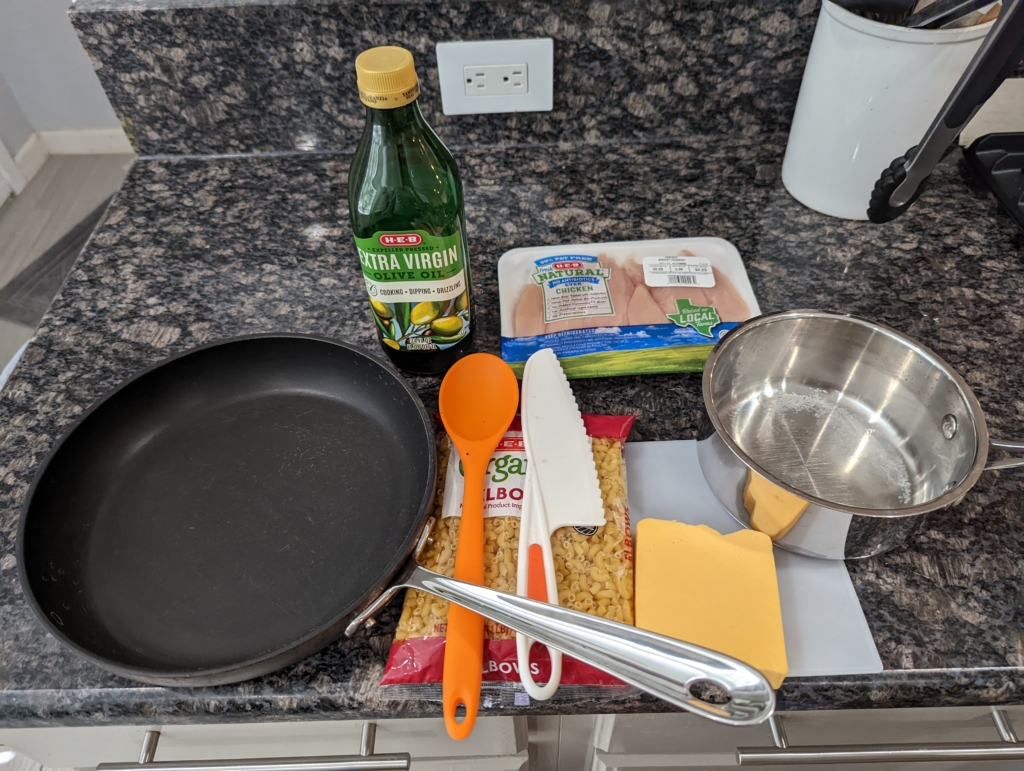
Step 1
Chop the chicken.
Step 2
Put the oil in a pan. Turn on the stove.
Step 3
Cook the chicken in the pan.
Step 4
Chop the cheese.
Step 5
Fill a pot with water and let it boil.
Step 6
Add pasta and let it cook.
Step 7
Drain the pasta.
Step 8
Add the chunks of chicken and cheese to the pasta.
Step 9
Mix. (If the cheese needs to melt more, add butter.)
Step 10
Munch your food!
Submit your and your child’s favorite recipe via the Contact Maya Form to get it featured in our Read with Me Recipe series, or comment with a recipe request!
Woo-hoo! It’s time for another Read with me Recipe—special recipes for kids that help them practice reading and spelling while making fun dishes together with their grownups. This recipe is sweet, it’s fresh, and it will help kids explore the different ways letters can make the double O sound (as in cool). Because today we’re making cool fruit smoothies!
Long vowel sounds can be a little tricky for children because they correspond to so many different letter combinations, and the long double O spelling pattern is extra tricky, because kids have to distinguish it from the single O sounds (as in hot and float). But if that sounds complicated, don’t stress! Kids learn these patterns little by little, and a bit of practice goes a long way. Make this recipe together and your child will be on the road to reading OO like a pro.
Before you start to make your fruit smoothie, demonstrate the OO sound in smoothie to your child and practice making it together. Have some fun! You can point out that it’s the same sound in “Oooh! That’s yummy!” Anything that helps them remember will add to the learning. Then explain that the sound can be made by the letters OO next to each other. I suggest handing them a pencil and encouraging them to try circling the OO patterns in the recipe. (For additional practice, check out our post “Teach Kids to Read OO Words.”)
For beginners, just focus on the OO pattern, but with children who are farther along their reading and spelling journey, help them circle all the long double OO sounds they find in reading the recipe. This will include these other “vowel teams,” too:
UI (as in fruit)
EW at the end of a word (as in few and new)
Read with Me Recipes
Our Read with Me Recipe series features printable recipes that are super easy to make and read with kids. They use simple words and short sentences typed in an easy font to set your little one up for reading success. Just print out the recipe and then read it with your child as you cook together. (Scroll down for tips on using it to help teach reading.) The idea is to make it easy for you to mix reading and writing into everyday life with your kids. This kind of “everyday literacy” is key to raising thriving readers.
What do you love to cook with your kids? Submit your favorite recipe. Or request a recipe you’d love to read (and make) with your kids! We’ll add them to our upcoming Read with Me Recipes.
Cool Fruit Smoothie
- 2 cups of fruit
- ⅔ cup of milk
- Ice
- Blender
- Safe knife
Note: If the fruit is frozen, you don’t need ice.
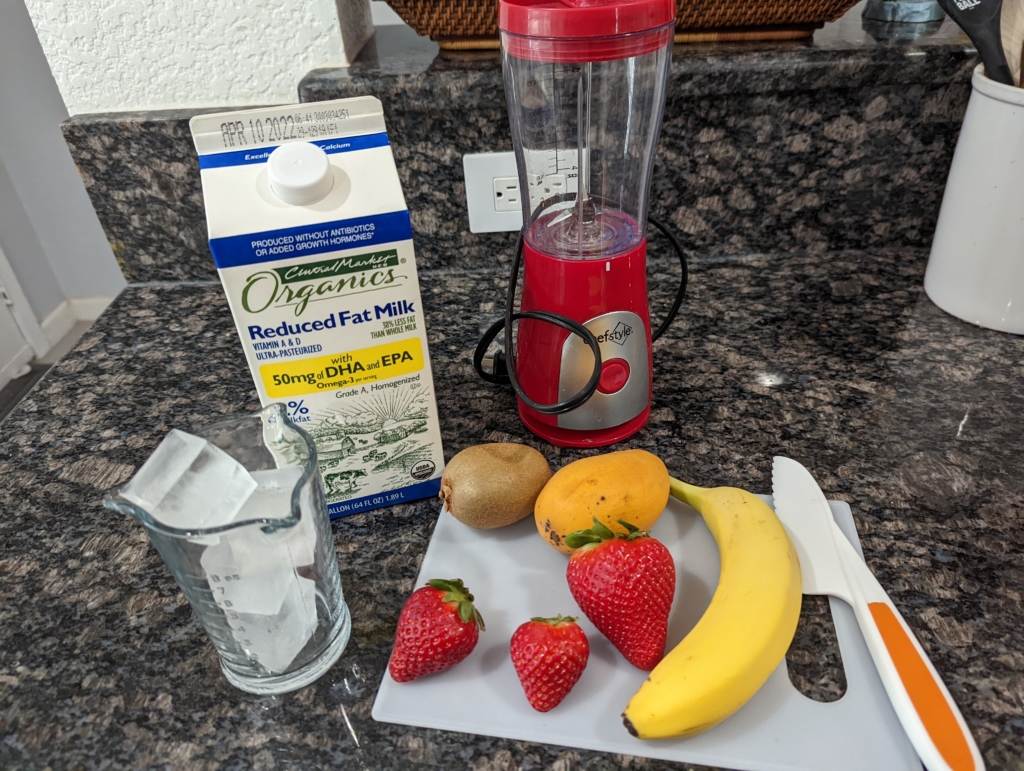
Step 1
Add a few ice cubes to the blender.
Step 2
Peel and cut the fruit. Try fruit you love and fruit that is new.
Step 3
Add the fruit to the blender.
Step 4
Add the milk too.
Step 5
Put the lid on the blender and blend until smooth.
Step 6
Enjoy your food!
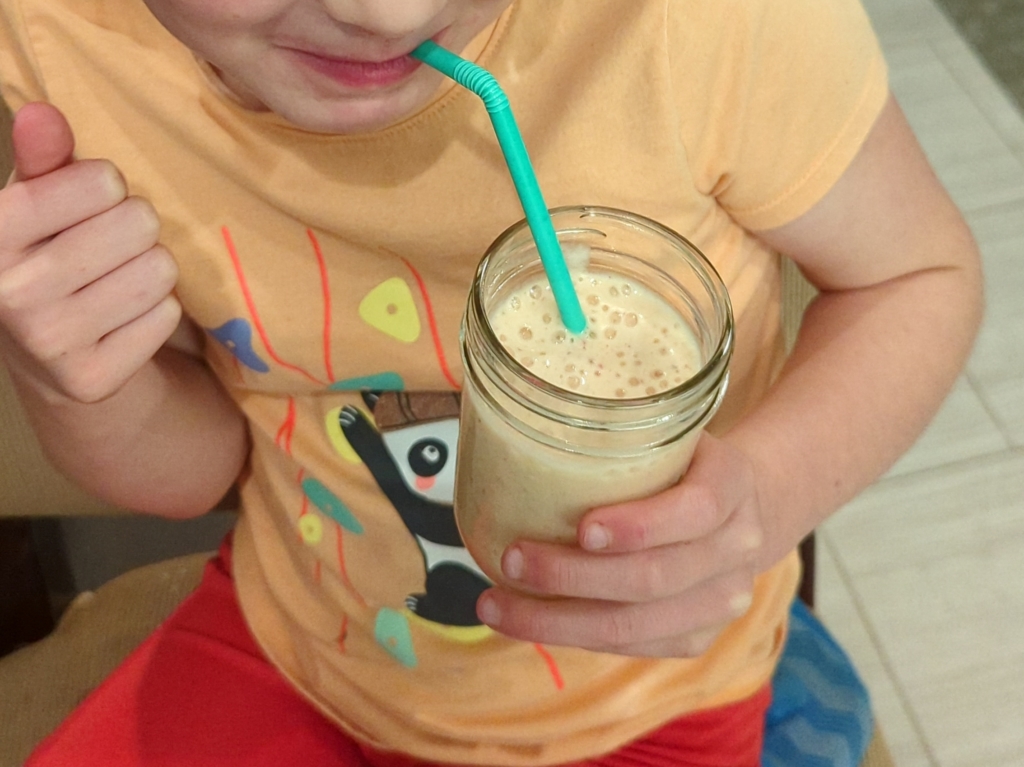
Tips for teaching kids to read with recipes:
- Introduce your child to how recipes work. If you’re not sure they know them already, be sure to explain vocabulary like “ingredients” and other cooking terms. (Even though we won’t be reading such complicated words in this recipe, they’re important words to learn.) One of the biggest challenges for beginning readers—and most important oral language underpinnings of literacy—is just knowing and understanding all the words they’ll encounter in print.
- Watch out for specific words in the recipe they may not be familiar with, and give a simple definition.
- Keep an eye out for tricky-to-read words, such as “ice,” “knife,” and “fruit.”
- For little ones who aren’t reading much yet, just pointing out what you’re reading and emphasizing a few key words or letters is enough. If you make the recipe again, you can help them find the words you pointed out before.
- Use this as an opportunity to show them punctuation, as well as words and letters. Point to the commas, periods, or other punctuation marks, and explain what they mean.
- If they can’t read the recipe on their own, give them chances for success by asking them about what they do know, gently underscoring key knowledge. E.g., ask, Can you find a letter O? or How many Os do you see in this word?
- For kids who are reading already, encourage them to read the recipe themselves. If they have trouble, just calmly help them with any words they can’t quite get. E.g., if they have trouble with the word “blender,” try covering “er” and helping them read just the first part of the word before you uncover the rest.
- Bring your patience. Give your child space to read a word (or identify a letter) before you jump in, but be prepared to help if they’re showing signs of frustration.
Submit your and your child’s favorite recipe to hello@mayasmart.com to get it featured in our Read with Me Recipe series.
Any parent who wants to raise a lifelong reader knows the importance of developing literacy skills, such as teaching your child the ABCs. But skills alone don’t keep kids reading in their free time and outside the classroom.
So what will motivate kids to read and keep reading? In this article, we’ll look at motivations for reading, and ways to instill them in your child. In particular, we’ll look at how to build what’s called intrinsic motivation. This means, for example, reading for personal reasons—like because it’s fun—as opposed to external motivations, like getting good grades. Intrinsic motivation tends to be much more powerful. In fact, one study showed children who are intrinsically motivated to read spend 300 percent more time doing it than those who aren’t.
And the end result of that motivation and all the reading it leads to? Not just better verbal skills and reading achievement, but many more benefits, including increased knowledge in various subjects, mathematical abilities, and mental wellbeing. So let’s take a look at five ideas for motivating kids to read.
Get Kids' Reading Motivation Going!
Make Reading Fun
This is a big one. Even when kids believe they can read well, that doesn’t mean they’ll be motivated to read, especially if they’re not sold on the point of it. But making reading enjoyable, and therefore something kids will want to do, is one area parents can help out with easily. Use reading as an opportunity to connect, soothe, and share laughter.
Depending on what sparks your child’s enthusiasm, you can set the mood for fun in different ways, from creating a cool reading den, to making story time an opportunity for incorporating games or activities, like this awesome pirate treasure map idea. On the flipside, try to avoid circumstances that might detract from the fun factor. For example, don’t put emphasis on finishing a book if your child isn’t enjoying it, and, if a book is too long for their attention span or too much of a stretch for their reading and comprehension skills, set it aside for another time.
As always, giving kids choice in what they read and allowing them to follow their own interests goes a long way towards increasing enjoyment and fostering deeper engagement. Sign them up for a library card, so they’re free to explore and pick out books that interest them. Magazines, books based on TV shows, and digital texts are all good too, as these tips for getting kids to read more attest. (And your library should have digital books for checkout, too, as well as physical books.)
Share The Book Love
We’re social creatures. In fact, psychologists view relating to others as one of three universal psychological needs—alongside competence and autonomy—that motivate human behavior. So it makes sense that enhancing the social aspect of reading can encourage kids’ motivation to read.
Reading together, talking about what you’ve read, and sharing books with others are powerful ways to harness the social connection that reading can bring. While in the classroom this might look like group activities based on a text, there are lots of ways parents can encourage a love of sharing books and reading at home.
Most basic and powerful are simply reading together and allowing lots of room for discussing books. But there are plenty of creative ways to make reading social, too. Think simple book swaps with other families (something my daughter loves to do with her friends as part of a playdate), using a favorite story as a jumping-off point for imaginative play (We’re Going on a Bear Hunt has been a go-to), visiting or building a Little Free Library, and doing book-related crafts and literacy activities together or with friends.
Boost Kids’ Confidence in Their Reading Abilities
When children believe they’re doing well with their reading, they’re more likely to want to read and more likely to rise to new reading challenges. So, fostering their confidence in this area by teaching them the skills they need and helping them to master them—through playful methods —is a powerful way to fire up a love of books.
For a preschooler, that might mean giving them access to texts that make them feel successful in early reading skills, like recognizing letters or spotting simple words. Or helping them develop their abilities without even realizing it, through light-hearted spelling games and engaging activities. For older children, board games can be one great way to practice reading and building vocabulary beyond books, while high-quality literacy apps can be fun, motivating and rewarding when it comes to rising to new challenges.
And if your child shows a deep love for or interest in a topic, reading and learning around that interest—from simpler picture books to videos or exhibitions—can give them the confidence to tackle more complex texts on the same subject. What’s more, the background knowledge they have gained will help them with their reading comprehension, which will in turn boost their sense of self-efficacy and motivation.
Honor the Value of Reading
As kids grow older, how much they value reading, and how useful and important they judge it, becomes increasingly relevant. And the good news is that parents can encourage kids to value books from early on. Just think of the powerful message that giving a book as a gift can send.
Allowing room for reflection during or after reading a book is another practice to build into family reading, and doesn’t have to be a didactic or structured activity. A thoughtful, open-ended question gives your child the space to come to their own conclusions, so let them surprise you with their insights and recognize the value of any takeaways on their own terms.
And if your child gravitates towards books on certain topics—like dinosaurs or space—give them free rein to follow their own interests. That way self-directed learning will become second nature, as will appreciating the role of books in expanding their knowledge and horizons. All of this will help them get, and recognize, value from reading.
Encourage Independent Engagement With Books
When a child is really motivated to read, they become an engaged reader who seeks books out on their own and interacts with them independently—sometimes called “self-selected” or “self-directed reading.” And independent readers, in turn, tend to spend more time reading, becoming better readers in the process, fueling the positive cycle. Independent reading thus helps create a positive feedback loop, building confidence and fostering a love of reading.
Giving kids access to interesting, balanced, and varied reading materials is the aim here. Long before they can read themselves, small children can enjoy books independently, from simply looking at the pictures to narrating wordless picture books or following along to an audio story with a hard copy book. They can also interact with books during shared reading—just provide lots of opportunity to discuss, or encourage them to “read” very familiar books from memory (something my daughter loved doing from around 15 months).
Parents are often said to be kids’ first and best teachers. The “first” part is guaranteed, but the “best” part must be earned. Don’t worry, though. As a parent, you’re perfectly positioned to teach your child to read—or, more accurately, to raise your child to read.
That’s because the necessary brain structure, comprehension, and skills develop from day one (well, even before) and continue developing day by day, week by week thereafter. And you have what teachers and tutors don’t have: years with your child.
You also have your own unique strengths to take advantage of along the way—once you know what they are. Each parent brings different experiences, quirks, and approaches to raising a reader. Together, I call these our raise-a-reader superpowers, because once we understand what we’re bringing to the table, we can learn how to leverage it to go from “first teacher” to “best teacher.”
So, what’s your raise-a-reader superpower? I’ve created a fun and easy quiz to find out.
Get Customized Next Steps for Raising Your Reader
After taking the quiz, you’ll understand how to build on your strengths to help your child become a reader (or a better and better reader). You’ll also get clear next steps for raising your reader, tailored to your personal profile, along with personalized must-read resources—so you can play to your strengths.
Who Should Take the Raise-a-Reader Superpower Quiz?
Whether you feel confident about raising a fantastic reader, or you have no idea if you can handle the job… Whether you look forward to helping your child read, provided you can sort through the reams of advice and information out there… or you dread tedious worksheets and flashcards… This quiz is designed to help you jumpstart your child’s literacy journey in a way that’s fun, easy, and natural to you—and rooted in evidence, drawing on the latest research.
I know you’re busy, and researching the best tools, teaching, and techniques for your child takes time. So I’ve done the heavy lifting for you, gathering resources that fit your superpower type, to help you help your child become a thriving reader. When you take the What’s Your Raise-A-Reader Superpower? quiz, you’ll understand your strengths (and maybe even your kryptonite!), so you can support your child toward success.
Happy May! Welcome to this month’s edition of Smart Story Time.
Keeping new books in the mix keeps family reading time fresh for your child (and you), as well as introduces them to new subjects and vocabulary. That’s why we curate some of our best recommendations for diverse picture books around timely topics each month. We hope this inspires you to find some awesome new-to-you reads for your child at your local library or independent bookstore.
Picture Books for Mother’s Day
OK, moms, dads, grandparents, and readers everywhere! You know this is an important day to celebrate all the hard-working mamas and mama-types out there. And naturally sharing or gifting a picture book is my personal favorite way to do it. Early childhood educator Chrysta Naron has curated a selection of darling picture books for Mother’s Day, plus a story time activity to go with them, in which you’ll make a lovely DIY Mother’s Day gift. Then extend the celebrations and the learning with an unforgettable Mother’s Day brunch, complete with a sweet keepsake menu handwritten by your child—see our post for tips and a free menu template printable.
Basketball Picture Books
Basketball is close to my family’s heart, and we understand how much this beloved game inspires young people all over. With the NBA Finals coming up, plenty of kids are feeling the basketball love right about now. Take advantage of this inspiration to do some themed reading with your child.
Austin writer Courtney Runn shares 12 inspiring picture books about basketball that will enthrall the little ballers in your life, all while imparting important lessons about everything from racism and resilience to perseverance and teamwork.
Kids’ Books about Senior Citizens
May is Older Americans Month, and that’s a great reason to celebrate grandparents or other senior citizens in your child’s life. It also offers an opening to delve into the topic of aging with your kids—and help them develop understanding, respect, and compassion for older neighbors, relatives, and friends.
Writer Karen Williams has curated a wonderful list of positive picture books about senior citizens and aging. Once you’re done reading, consider helping your child act on what they’ve read. Reach out to an elderly neighbor, make a date with a relative, or read Karen’s post on how to write letters to a senior citizen. The article includes links to organizations that will send your child’s notes to nursing homes or set them up with a senior pen pal.
Picture Books about Your Child’s Interests
MayaSmart.com is your one-stop-shop for raising a reader. Check out our other kids’ book lists and articles. In addition to bringing books into your reading time that tackle timely topics or important subjects, be sure to follow their interests, as well. If your kid loves science or animals—read about those topics. Following their interests keeps them engaged and helps you build a responsive relationship with your child.
We’ll be back next month with the next installment of Smart Story Time. Meanwhile, feel free to message me with requests for future posts, book recommendations, or just to say hi!
What are you reading with your child this month? Connect on social media & let me know!
As a parent, the time you spend with your child—reading aloud, chatting, and interacting in countless ways—is pivotal in helping them develop and thrive as a reader, writer, and thinker. From teaching your child the alphabet to playing rhyming games, you instill crucial knowledge and skills through fun, playful time together. Best of all, it builds your relationship, too—and can even help you feel happier and more fulfilled.
That’s why each month we share a special list of featured reads and literacy activities. Expect fun seasonal reading recommendations, complemented with activity tutorials and free printables for an all-out story time experience with your little one.
Here are some topics to delve into with your child this month:
Thanksgiving Picture Books
What are you thankful for this year? We know what we’re giving thanks for: the shared joy of story time. When we cuddle up our little ones and enjoy a pile of books together, we make priceless memories to cherish every day. This month, we’re building memories and gratitude by reading thoughtful books about Thanksgiving and the concepts we want it to embody for our families. There are so many aspects of the holiday to explore, from history and inclusiveness to giving thanks, the value of simple time with loved ones, and—of course—cooking.
Think about what matters to you and then seek out some recommendations from your local librarian or bookstore owner. Also, Chrysta Naron’s article about Picture Books for Fall Holidays lists some great Thanksgiving books for kids: The Thankful Book by Todd Parr and Balloons Over Broadway: The True Story of the Puppeteer of Macy’s Parade by Melissa Sweet, plus some wonderful books by and about Indigenous Americans (more on this below!).
Kids’ Books By and About Indigenous Americans
We advocate including books by and about Indigenous Americans in your child’s book rotation all year long, but November offers many additional teachable moments. Your child may have questions about the origin of Thanksgiving or the history they’ve heard about in school and elsewhere. The holiday also offers an entry point into the topic for children.
Read this post about how to choose great reads to introduce Indigenous American authors and stories to your little one, and then be sure to scroll down in the post to find recommendations of some excellent books to get you started. Also check out Squanto’s Journey: The Story of the First Thanksgiving by Joseph Bruchac—you’ll find a write-up of this one near the bottom of the Favorite Picture Books for Fall Holidays post!
And (Always) Books Your Child Loves
In addition to reading books that tackle timely topics or important subjects, be sure to follow your child’s interests, as well. Whether your kid loves superheroes or sports, cooking or gardening, science or animals, reading plenty of books relating to topics they’re into can keep them engaged and build your relationship.
Check out our other kids’ book lists and articles for curated reading lists on various topics. You’ll also find book lists tailored to fostering specific literacy and life skills, from learning to read (and spell) with silent E to developing empathy and body positivity or dealing with grief.
Story Time Activity: DIY Gratitude Animals
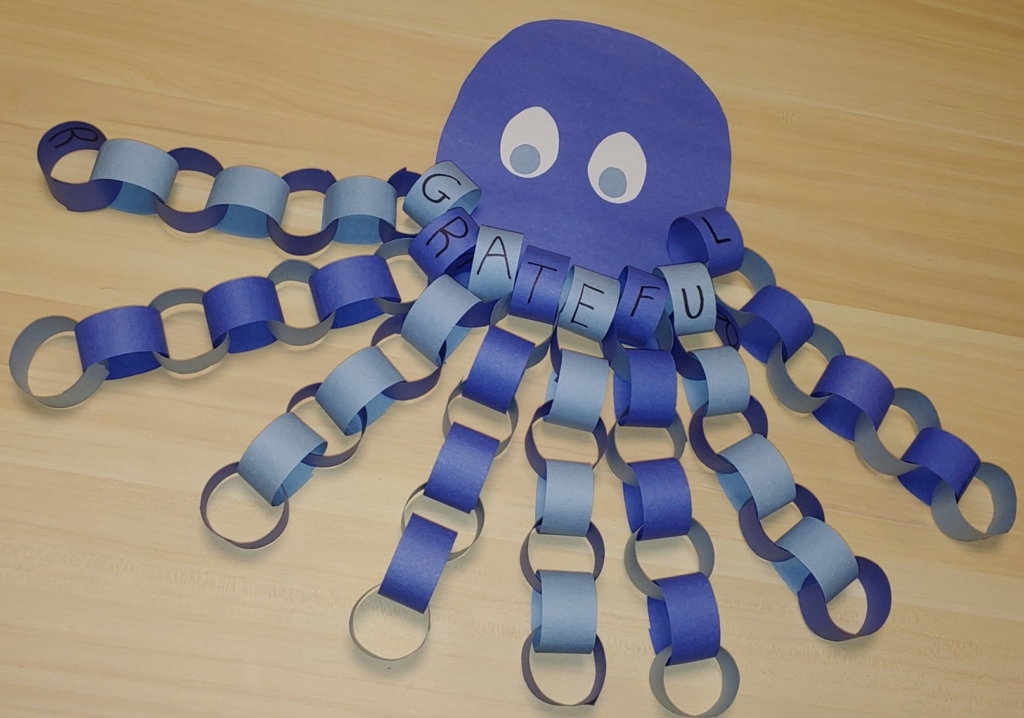
Practicing gratitude is valuable for mental and emotional well-being. Combine this with some literacy practice while creating cute decor for your house in this sweet DIY gratitude craft to do with kids.
Enjoy this post? Please share it on social media.
New to MayaSmart.com?
Welcome! It’s lovely to have you here. I’m Maya, an author, literacy advocate, and mom. On this site, I publish articles, advice, book recommendations, and activities for busy parents. Through it all, my goal is to help parents like you feel equipped and confident to support your children in reading. Let’s start by understanding what you bring to the effort—your unique superpower.
Find your raise-a-reader superpower now.As a parent, the time you spend with your child—reading aloud, chatting, and interacting in countless ways—is pivotal in helping them develop and thrive as a reader, writer, and thinker. From teaching your child the alphabet to playing rhyming games, you instill crucial knowledge and skills through fun, playful time together. Best of all, it builds your relationship, too—and can even help you feel happier and more fulfilled.
That’s why each month we share a special list of featured reads and literacy activities. Expect fun seasonal reading recommendations, complemented with activity tutorials and free printables for an all-out story time experience with your little one.
Here are some topics to delve into with your child this month:
Halloween Picture Books
For a lot of us, October means Halloween, complete with jack-o-lanterns, fun decorations, costumes, and treats. And sharing some sweet reads with your little one is a treat you can both enjoy. Visit educator Chrysta Naron’s article on great kids’ books for fall holidays and scroll down to find some recommended picture books for Halloween. You’re also sure to find plenty featured at your local library!
Then move beyond the page and incorporate reading into other parts of your Halloween celebrations. For example, pick a book-character costume for your child or yourself, or get more ideas in Chrysta’s article on how to make Halloween a reading holiday.
Kids’ Book about Dia de Los Muertos
Dia de Los Muertos means “Day of the Dead” in Spanish. This tradition from Mexico, now celebrated in many Latin American countries and others, is all about celebrating loved ones who have died. Emphasis on the “celebrating”—the tradition abounds with love, flowers, special foods, candles, and joy.
Dia de los Muertos takes place at the start of November, right after Halloween, so this month is a great time to read up and get in the mood! You’ll find Chrysta’s picks for some great Dia de los Muertos picture books in her fall holidays books post.
Mid-Autumn Moon Festival Kids’ Books
Also called the Moon Festival or the Mooncake Festival, this holiday is traditionally celebrated in many parts of Asia, including China, Korea, Taiwan, and Vietnam. The day is based on the Lunar calendar and happens each year sometime between September and October. In 2025, it’s early in October.
It’s a celebration of the Autumn harvest and takes place (as you might have guessed) at night! Families gather with lanterns, mooncakes, and starfruit to celebrate together. To read about this long-standing tradition with your kids, check with your local library for some good books, or you can also find a couple of lovely picture books about the Mid-Autumn Moon Festival recommended in the fall holidays post mentioned above.
Picture Books about Diwali
Diwali, or the Festival of Lights, is coming up at the end of this month, too. The biggest holiday of the year in India (though it is celebrated around the globe), it’s observed by Hindus, Sikhs, Jains, and some Buddhists.
The festival takes place over several days, with prayers, feasts, decorations like intricate sand art called rangoli, the lighting of lamps, and many other traditions. Though different regions and groups have differing stories about the origin of Diwali, the various celebrants recognize it as a holiday about the triumph of good over evil or light over darkness. Contributor Chrysta Naron has curated a list of awesome Diwali books for children.
Story Time Activity: Roasted Pumpkin Seeds
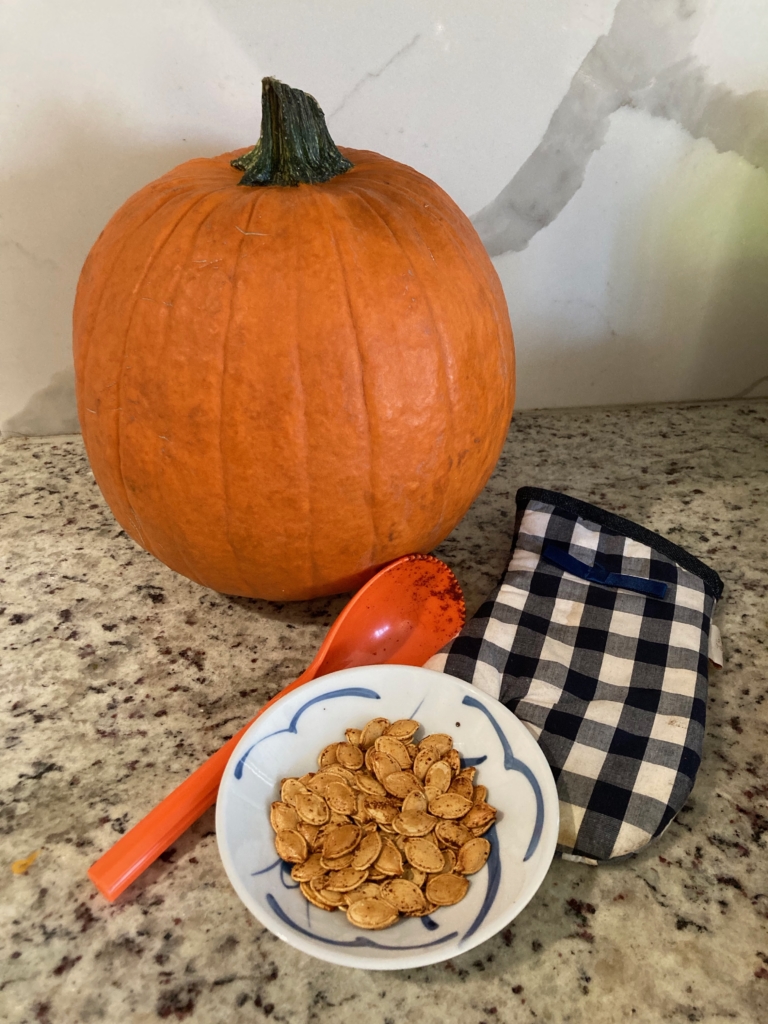
Roast some pumpkin seeds with your child for a tasty seasonal snack this month. Check out our Read With Me pumpkin seeds recipe that’s written in simple, child-friendly language so that you can sneak in a reading lesson as you prepare it.
Enjoy this post? Please share it on social media.
New to MayaSmart.com?
Welcome! It’s lovely to have you here. I’m Maya, an author, literacy advocate, and mom. On this site, I publish articles, advice, book recommendations, and activities for busy parents. Through it all, my goal is to help parents like you feel equipped and confident to support your children in reading. Let’s start by understanding what you bring to the effort—your unique superpower.
Find your raise-a-reader superpower now.As a parent, the time you spend with your child—reading aloud, chatting, and interacting in countless ways—is pivotal in helping them develop and thrive as a reader, writer, and thinker. From teaching your child the alphabet to playing rhyming games, you instill crucial knowledge and skills through fun, playful time together. Best of all, it builds your relationship, too—and can even help you feel happier and more fulfilled.
That’s why each month we share a special list of featured reads and literacy activities. Expect fun seasonal reading recommendations, complemented with activity tutorials and free printables for an all-out story time experience with your little one.
Here are some topics to delve into with your child this month:
Picture Books About Martin Luther King, Jr.
There are hundreds of books dedicated to exploring the life, dreams, and work of Dr. Martin Luther King, Jr. So how’s a parent to choose which books are best to explore with their child?
Read Maya’s article, Celebrate Martin Luther King, Jr. with 13 Thought-Provoking Books, to get tips for finding the right-fit book to deepen your child’s knowledge of King’s legacy and the American history it so vividly illustrates. You’ll also find specifics about a bunch of great kids’ reads to explore this topic around Martin Luther King Day.
Story Time Activity: Word Snow People
Whether it snows in your area or not, nothing says winter like making snow people! So for this month’s featured activity, we’re making paper “snow” families that teach kids reading skills and make cute decorations for your home. All you need for this easy activity is 15 minutes and some basic materials. Get the word snowmen tutorial.
Early childhood educator Chrysta Naron created this cute winter craft for us as a way to teach kids word families—groups of rhyming words that share the same ending (both the spelling and pronunciation). For example, the “-op” rhyming word family includes words like hop, top, and pop. Word families help kids learn spelling patterns that make it easier to read and write new, related words.
Book Pairing: Read a snow-related book or two to set the scene for your craft. Some favorites from Chrysta include Snowmen at Night by Caralyn Buehner and illustrated by Mark Buehner, The Snowy Day by Ezra Jack Keats, A Big Bed for Little Snow by Grace Lin, and Snowballs by Lois Ehlert. Look for word families as you read!
New to MayaSmart.com?
Welcome! It’s lovely to have you here. I’m Maya, an author, literacy advocate, and mom. On this site, I publish articles, advice, book recommendations, and activities for busy parents. Through it all, my goal is to help parents like you feel equipped and confident to support your children in reading. Let’s start by understanding what you bring to the effort—your unique superpower.
Find your raise-a-reader superpower now.